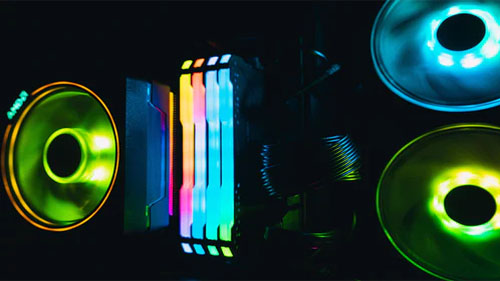
Ultimate Guide to Choosing the Right Addressable LED Strip

LED strips are a great choice when you need a dynamic lighting solution. They come in different colors, can be installed just about everywhere, and are quite low-maintenance. You would have a hard time finding another lighting solution that delivers as much value and style.
Addressable LED strips, however, lift the bar to a whole new level. They offer you more control options with cool effects to make your lighting set up even more dazzling. The catch is, you need to pick the right kind of addressable LED strip for your needs.
If you are worried about how to make that decision, don’t fret. Read on to find out all you need to know about choosing addressable LED strips.
Table of Contents
What Are Addressable LED Strips?

Addressable LED strips are light strips that have unique chips that allow you to control individual LEDs or groups of them. This extra provision to control a specific part of the strip is why they are referred to as ‘addressable’. It allows you to create different effects on different parts of the LED strip all at once or in intervals. It is ideal for depicting animations and similar dynamic displays.
How Do Addressable LED Strips Work?
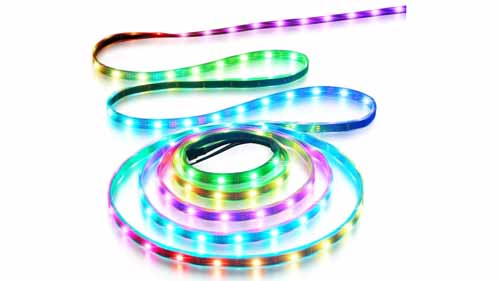
The working of an addressable LED strip is a concerted effort of different parts. They include:
- Integrated circuit chips
- Light-emitting diodes (LEDs)
- A power source
- A controller
Each LED has a dedicated integrated circuit chip. This is what makes it possible for you to control individual LEDs. The controllers used to manipulate them are also unique; they have data channels to relay commands and not just matching RGB pins like those of typical RGB LED strips.
With that in mind, the addressable LED strip thus works as follows:
- When the power source is turned on, a direct current flows to the LEDs causing them to light on default settings.
- To create an effect, you would input a command on the controller to address the particular LEDs you would like to control.
- The controller then relays a corresponding signal to the integrated circuit chips on those LEDs.
- The circuit chips execute the command instantly or store it for a timed execution if, for instance, you have entered a timed-interval lighting effect.
Important Factors to Consider When Choosing Addressable LED Strips
Whereas the basic working principle of addressable LED strips is the same, some design factors impact their performance. It is advisable to consider pertinent factors such as:
Voltage

Addressable LED strips come in 3 voltage varieties; 5V, 12V, or 24V. Ideally, the higher the voltage, the better. If you are wondering why, the answer to your curiosity lies in a phenomenon known as voltage drop.
As voltage travels through an LED strip, it meets electrical resistance in the wiring. For this reason, the voltage at the beginning of the strip is not the same as that at the end of the strip. This may cause the light to be dimmer on some parts than others. However, if the voltage is higher even with resistance, there is enough left to power the LEDs as needed.
The Type of LED Chip

LED chips are largely responsible for the quality of light emitted by an addressable LED strip. They differ based on size and the colors they can produce. Some common types include:
SMD 5050
It is a wider chip measuring about 5mm by 5mm and can house 3 LEDs. On the upside, it can produce more color options and brighter light. Nonetheless, it produces high heat which can sometimes cause malfunctions if the heat is not well dissipated.
SMD 3528
This is a narrower chip which can be convenient where a thin addressable LED strip is needed. It measures about 3.8mm by 5mm. You will not have to worry about high heat with this LED chip but it presents other limitations. It can only accommodate 1 LED and its lighting is thus not very bright. Plus, only one color can be displayed.
LED Density

LED density refers to how many LEDs there are in one meter of an addressable LED strip. The question you need to ask yourself here is how much light intensity you would like. If you would like intense lighting, aim for a strip with a high number of LEDs.
The Nature of the Installation
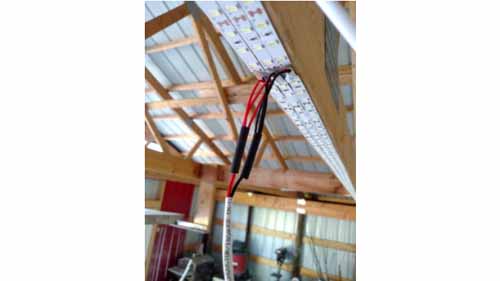
Consider the size of your installation as well. Addressable LED strips with higher voltage are ideal for large installations as they can sustain voltage over a large distance with less wiring. A 12V LED strip, for example, would be a perfect balance between energy efficiency and reduced voltage drop.
Types of Individually Addressable LED Strips
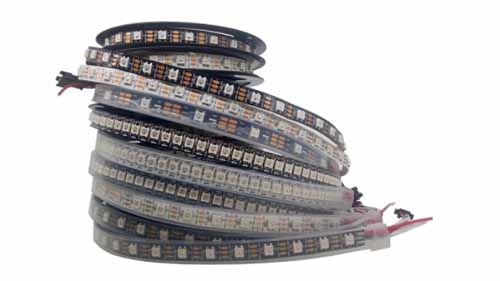
Addressable LED strips are distinguished by the type of Integrated Circuit Chip(IC) they contain. This is because the ICs play a crucial role in how the whole strip functions. As you compare different brands, you may encounter Integrated Circuit Chip options such as:
- WS2811
- WS2812
- WS2813b
WS2811 Vs WS2812 Vs WS2813
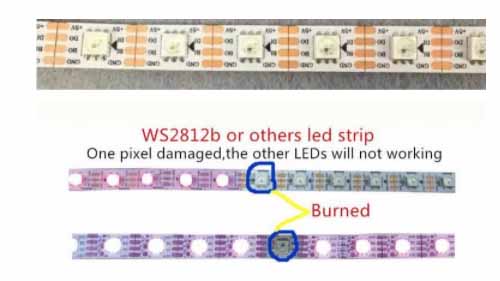
To help you make an informed decision, let us compare the features and drawbacks of these 3 key options.
WS2811
This is an external chip that you can find in 12V and occasionally, 5V varieties. The 12V is preferable as you would enjoy longer strip lengths with less voltage drop. It also provides great color consistency throughout the strip.
On the flip side, most microcontrollers used to control addressable LED strips can only handle 5V. As a result, you will need a different power source for your controller. Further, due to its higher voltage requirements, this type of addressable LED strip will have a higher power draw.
In terms of control, this integrated circuit chip allows you to control a channel of 3 LEDs with each command. It is, therefore, not your ideal choice if you need to control each and LED on its own.
WS2812B Vs WS2813
These 2 options are more comparable on a level footing. They share similar features although the WS2813 is a more advanced integrated circuit chip than the WS2812B.
WS2812B
WS2812B
WS2813
Voltage
5V
5V
Integration
Internal
Internal
Refresh Rate
400Hz
2000Hz
Signal Relay
Data-in channel
Data-in and Backup-in channels
LED Chip Compatibility
SMD 5050
SMD 5050
Color Display
RGB
RGB
Recommended Power Injection intervals
5M
2.5M
Chip integration style- both of these circuit chips are in-built.
Voltage- addressable LED strips with WS2812B or WS2813 ICs are often 5V models. They are energy efficient but may require a voltage injection if you hope for a consistent color display. Alternatively, you can have them custom-made with a higher voltage provision.
Controller Type- both ICs can be controlled using the same type of controller given as their voltage provisions are the same and they respond to digital prompts.
Digital signal relays- each of these integrated circuit chips receive prompts from the controller digitally. The prompt is then relayed to the adjacent chips in a serial communication kind of set up.
In WS2812B chips, this presents a big challenge because when one IC malfunctions, the circuit breaks. Prompts can not be transmitted to the next chip.
However, the WS2813 has 2 channels to receive prompts: data in and backup in. If the data-in circuit breaks, signals can still be passed on through the backup-in channel as long as not more than one LED chip has failed.
Refresh rates – the WS2813 has a higher refresh rate than the WS2812B. It would be a better choice if you need a seamless display of colors or videos.
Where to Buy Addressable LED Strips

All addressable LED strips are not the same, each brand has unique properties. This is why it is essential that you choose the right addressable LED strip manufacturer. Admittedly, that too might be a tricky endeavor but here are some key indicators to look out for as you shop:
Pricing – addressable LED strips are affordable lighting solutions and thus aim for a brand that offers you value for money.
Quality – the quality of components a brand uses will tell you all you need to know about the quality of their addressable LED strips. High-quality chips, backboards, and silicone jacketing are a plus.
Customer service- aim for a brand that avails you of all the information you need regarding their products. If they can offer you sample addressable LED strips or a warranty, that is a brand you can trust.
Customization services – if you have special installation or addressable lighting requirements, your ideal brand is one that can rise to the challenge and customize your addressable LED strips to your needs.




